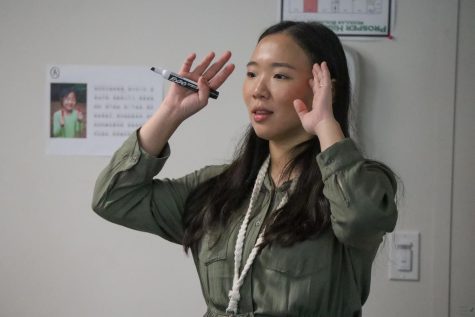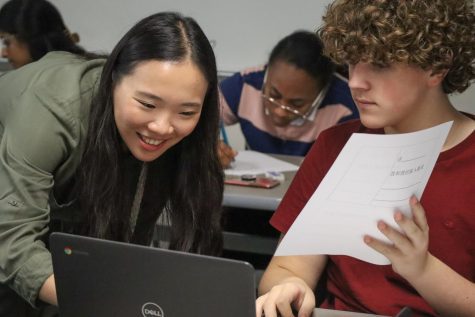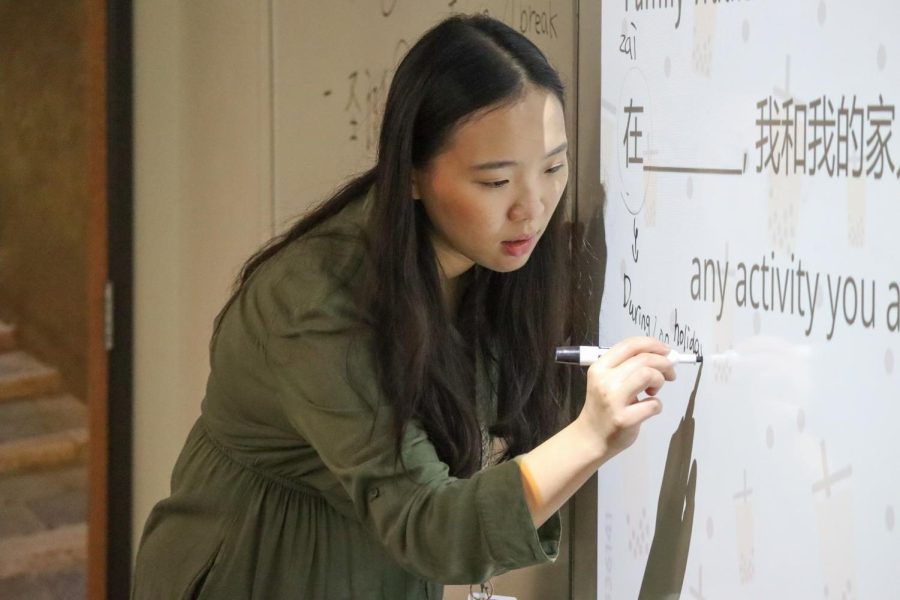Mandarin teacher fosters appreciation for Chinese culture
Amy Kao leads classes at 2 campuses
Writing on the board, Kao shows her students Chinese characters. “I enjoy the classroom environment,” freshman Michelle Kumanova said. “I feel like it’s very inviting, and nice and cozy.”
In a small classroom located in the portables, Amy Kao stands by the door ready to greet students. Once the bell rings, Kao, already in her seat, pulls up a slideshow to teach students Mandarin Chinese. Kao knew from the beginning of her career that teaching Mandarin would become a devotion of hers.

“I have been wanting to teach Chinese overseas since I was in college,” Kao said. “I really enjoy developing stronger cross-cultural sensitivity in the classroom with my students.”
Kao started teaching after graduating college, first working as a kindergarten teacher.
“I am glad after teaching kindergarten, I finally got a chance to be a Chinese teacher in Prosper ISD,” Kao said. “I was teaching in the Carrollton and Princeton ISD for the past three years.”
Although she was not teaching Mandarin in Carrollton and Princeton, she was working with students.
“I spent most of my childhood there,” Kao said. “One of the most different things between Taiwan and America is you would barely see a single house there. Most people live in apartments because Taiwan’s so small. Think about Texas. It’s 19 times bigger than Taiwan alone.”
Kao was born and raised in Taipei, Taiwan. Moving to America was a culture shock for Kao.
“Growing up in Taiwan makes me become a person who cherishes nature more,” Kao said. “I could barely see it in the city when I grew up in Taipei. I have been enjoying most of my time here in Texas, because there are lots of parks that you can take a walk in your neighborhood and less crowded living areas.”

Kao received her degree from Tzu Chi University.
“(I got my degree in) Bachelor of Art in English literature,” Kao said. “And teaching Chinese as a second language.”
When Kao moved to America, she attended Tarleton State University and received her master’s degree in curriculum and instruction. In Kao’s first year teaching at Prosper ISD, she said she has grown to love the students in her class. Kao currently works at Prosper and Rock Hill High school. She teaches 42 students at Prosper and 37 at Rock Hill.
“I think knowing my students feel excited to be in my class and learn Chinese gives me the motivation to be there for them,” Kao said. “I always tell my students they are learning the hardest language in the world. And I think the greatest achievement that I have achieved so far is seeing my students feel safe and confident speaking Chinese in the classroom.”
I feel my happiest when I see my students are trying their best to speak as much Chinese as they can in the classroom.
— Amy Kao

In class, Honors Chinese I and Honors Chinese II students are currently learning how to say their classes, what order they have to be in, what supplies they will use in those classes and the time that it starts and ends. In the last unit, they learned how to introduce their family by describing what they do, what they like and what they like to do.
“One of the major challenges that we have in the Chinese class is teaching students how to write Chinese characters. For example, ‘Hello’ in Chinese is ‘你好’,” Kao said. “Students have to recognize the characters and also need to be able to type that on their computer. I do lots of practice with my students, I try my best to expose them to as many characters as I can during class time.”

“Students can feel safe both mentally and physically when they walk into my Chinese classroom,” Kao said. “Also, I look for my Chinese students to be able to apply what we learn into a real life situation. My goal is preparing my students to have a better understanding of both Chinese language and cultures.”
Freshman David Makanju said he appreciates Kao and the way she teaches the language.
“I really enjoy all the people in it, you know, so much diversity. It makes the classroom more lively as well. And, Mrs. Kao, she’s amazing, because she’s so nice and understanding,” Makanju said. “I think taking Chinese would have been harder, it wasn’t like a thought for me but my dad suggested this occasion. It wasn’t my first choice, I wanted to take like Spanish or something, but I’m really happy that I chose this class.”
Freshman Shen Kai “Brian” Zhang takes Honors Chinese to keep up with Chinese, his first language.
“The people are just very approachable. The entire vibe of the class is approachable and the teacher made the content very like, just it’s not scary to learn,” Zhang said. “It’s a different experience. It’s definitely different from what you would expect, like the normal curriculum. It’s not like an English class. It’s more so you get to attempt to socialize, and kind of emulate the natural way, how you would just socialize.”
Kao said she’s determined not only to impact her students in class, but hopefully help them set a better mindset.
“The impact that I would like to make in the class involves not only teaching Chinese, but fostering the student’s self-esteem in learning a new language. Reinforcing their confidence in the classroom is associated with increased motivation and learning,” Kao said. “To minimize a student’s fear of making mistakes, I advocate for lots of positive reinforcements during class to make sure students feel loved and heard.”
Your donation will support the student journalists of Prosper High School. Your contribution will allow us to purchase equipment and cover our annual website hosting costs.

Honors & Awards
2 Best of SNO publication
1 BITS Award
1 UIL Honorable Mention in Feature Writing
1 TAJE Excellent in Feature Writing













